Synthetic spider silk fiber exhibits exceptional tensile strength and elasticity, surpassing aramid fiber in energy absorption and flexibility for body armor applications. Its lightweight, biodegradable properties offer enhanced comfort and environmental benefits compared to the heavier, petroleum-based aramid fibers.
Table of Comparison
| Property | Synthetic Spider Silk Fiber | Aramid Fiber |
|---|---|---|
| Tensile Strength | Up to 1.6 GPa | 3.0 - 3.6 GPa |
| Density | 1.3 g/cm3 | 1.44 g/cm3 |
| Elasticity | High (up to 30% elongation) | Low (2-4% elongation) |
| Impact Resistance | Excellent energy absorption | High resistance, less flexible |
| Thermal Stability | Moderate (up to 150degC) | High (up to 400degC) |
| Weight | Lightweight | Moderate weight |
| Durability | Good, biodegradable | Excellent, chemically resistant |
| Cost | High production cost | Moderate to high |
| Applications | Next-gen body armor, flexible protection | Standard bulletproof vests, helmets |
Overview of Body Armor Materials
Synthetic spider silk fiber demonstrates exceptional tensile strength and elasticity, surpassing many conventional materials used in body armor, including aramid fibers such as Kevlar. Aramid fibers provide high impact resistance, thermal stability, and lightweight protection, establishing them as a standard in ballistic vests. Emerging research highlights synthetic spider silk's potential for enhanced flexibility and biodegradability, making it a promising alternative for next-generation body armor materials.
Introduction to Synthetic Spider Silk Fiber
Synthetic spider silk fiber exhibits exceptional tensile strength and elasticity, rivaling and often surpassing traditional materials used in body armor such as aramid fibers like Kevlar. Its biocompatibility, lightweight properties, and ability to absorb high impact energy make it a promising alternative for next-generation protective gear. Advances in bioengineering enable scalable production of synthetic spider silk, enhancing its potential for integration into flexible, durable, and lightweight body armor solutions.
Characteristics of Aramid Fiber
Aramid fiber, renowned for its exceptional strength-to-weight ratio and heat resistance, plays a critical role in body armor by providing superior ballistic protection and durability under extreme conditions. Its chemical structure delivers high tensile strength, resistance to abrasion, and stability at temperatures up to 500degF (260degC), outperforming many synthetic materials in impact absorption. Unlike synthetic spider silk fiber, aramid fiber benefits from established industrial-scale production, ensuring consistent quality and widespread availability for protective applications.
Tensile Strength Comparison
Synthetic spider silk fiber exhibits tensile strength ranging from 1.0 to 2.0 GPa, closely mimicking the natural silk produced by spiders, while Aramid fibers such as Kevlar offer tensile strengths between 3.6 and 4.1 GPa, making them significantly stronger under tension. Despite lower tensile strength, synthetic spider silk fibers provide exceptional toughness and elasticity, enabling energy absorption and impact resistance beneficial in body armor applications. The superior tensile strength of Aramid fibers ensures high resistance to tearing and penetration, yet their brittleness contrasts with the flexibility and durability of synthetic spider silk composites.
Flexibility and Comfort Analysis
Synthetic spider silk fiber exhibits superior flexibility compared to aramid fiber, allowing for enhanced mobility in body armor applications. Its lightweight and high tensile strength contribute to increased wearer comfort by reducing bulk and stiffness often associated with aramid fibers. The elasticity of synthetic spider silk also improves impact absorption, making it a promising material for next-generation flexible body armor.
Weight and Thickness Considerations
Synthetic spider silk fiber offers superior strength-to-weight ratio compared to aramid fiber, resulting in significantly lighter body armor without compromising protection. Its finer fiber diameter allows for thinner armor layers, enhancing wearer mobility and comfort in tactical situations. Aramid fibers, such as Kevlar, tend to be bulkier and heavier, making synthetic spider silk a promising material for lightweight, low-profile ballistic protection.
Ballistic Performance Evaluation
Synthetic spider silk fiber demonstrates superior tensile strength and energy absorption compared to traditional aramid fibers, making it a promising candidate for next-generation body armor. Ballistic performance evaluations reveal that synthetic spider silk fibers offer enhanced flexibility and lightweight protection without compromising resistance to high-velocity projectiles. Research indicates that incorporating synthetic spider silk in composite layers can significantly improve multi-hit capability and reduce trauma behind the armor compared to standard aramid fiber panels.
Environmental Impact and Sustainability
Synthetic spider silk fiber offers a significantly lower environmental impact than aramid fiber due to its biodegradable properties and renewable production methods using genetically engineered organisms. Aramid fibers, commonly used in body armor, rely on petrochemical processes that contribute to high carbon emissions and are non-biodegradable, raising concerns about long-term sustainability. The scalability of synthetic spider silk production promises reduced ecological footprint and enhanced sustainability for future body armor materials.
Cost and Scalability Factors
Synthetic spider silk fiber offers promising scalability due to advances in biotechnological production methods, potentially lowering costs compared to traditional aramid fibers like Kevlar. While aramid fibers benefit from established manufacturing infrastructure and consistent performance, their production involves complex chemical processes that drive higher material and processing costs. Synthetic spider silk fibers, relying on recombinant DNA technology and microbial fermentation, could scale up with reduced environmental impact and cost efficiency, making them a competitive alternative for next-generation body armor.
Future Trends in Body Armor Technology
Synthetic spider silk fiber, known for its exceptional tensile strength and biodegradability, offers promising advancements in lightweight and flexible body armor compared to traditional aramid fibers like Kevlar. Emerging trends emphasize integrating synthetic spider silk to enhance ballistic resistance while improving wearer comfort and environmental sustainability. Innovations in bioengineering and nanotechnology are driving the development of hybrid composites that combine spider silk's natural toughness with aramid fibers' proven durability for next-generation protective gear.

Infographic: Synthetic spider silk fiber vs Aramid fiber for Body armor
 azmater.com
azmater.com